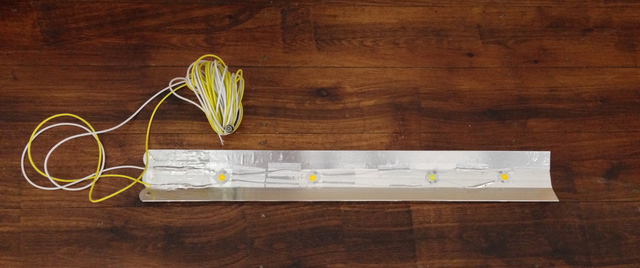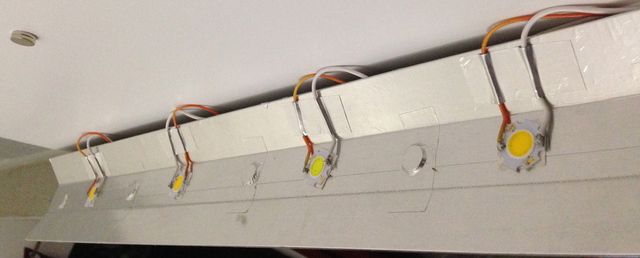High-power LEDs for super-bright light
I've been "playing" with COB LEDs for about half a year now. Here's a summary of my experience.
Preliminaries
COB LEDs
A "COB LED" is a basically a bunch of tiny LEDs put on together to provide a very energy-efficient and usually very bright LED (using both parallel and series circuit schemes). Note that it means the voltage of COB LEDs are not the voltage of "normal LEDs", since putting some LEDs in series means adding up voltage values!
An LED does not behave like an incandescent light bulb
Also, note that if there's a roughly linear relation between light intensity and voltage for classic lamps, it's not the case at all with LEDs! With LEDs, basically, the light intensity varies with the amperage, not the voltage. So if you lower the voltage by a very little bit, it will shine as bright if the amperage keeps up; if you lower the voltage too much, it basically stops emitting light (e.g., if you give it 16V instead of 19V, you have so little light that it's really useless), but if you increase the voltage too much you still fry your LEDs so you don't want to do that at all.
Light colors, measured in Kelvin
Basically, 2700K to 3300K correspond to classic (discontinued) incandescent light bulbs, and it's quite close to classic candle light, which is about 1850K. 6500K is day light as in "the light provided by the Sun on a sunny day at noon", which seems very cool if it's dark outside or if you have warm light around. My favourite artificial light color is generally from 4000K to 5000K. I find the 3000K quite acceptable, below that is too warm, above 6000K is too cool.
Don't get me wrong: in this post, "cool" not a synonym for "awesome", stick to its original meaning instead.
Color spectral distribution
Note that LEDs generally have a very narrow light color spectrum. That means that instead of emitting light of a lot of different colors, including some colors you don't see or colors that are not very much noticed because they are less intensively emitted, LEDs will really emitt just the color you asked for. That is not such a good thing (it's not so bad either). But as a consequence, you might feel that the light emitted by an LED is not very comfortable. What I do is that I mainly use warm light LEDs and I add a few cool light LEDs amongst them: it goes from 1 cool for 6 warms to 1 for 1. The result of 1 for 1 is quite nice when it's bright outside, but it's not so nice if it's in the middle of the night.
spectral power distribution: read more on Wikipedia.; find more on Google.
LED color rendering index: read more on Wikipedia.; find more on Google.
Why not simply buy normal lamps?
Well, buying new lamps for having more light implicates buying light bulbs as well. I'm not a very big fan of light bulbs that contain mercury because if you ever break one, you'll breathe mercury gas (much likely in small quantities though). And I can't install lights on the wall without asking my landlady for permission, and even if I did have permission, it would mean putting electric wires inside the wall and that's not really an idea that speaks to me (I've never done that) and that means painting the wall afterwards (not a big fan of painting walls either). What about LEDs then? Don't I need to install them on the wall anyway? Well, no, I don't! I have access to some of the iron based framework, and as LEDs are light weight and flat, I stick them on some material on which I put some magnets, et voilà! (Now I'm even a bigger fan of strong magnets than before.)
Well, I won't deny it, the main reason why I wanted to use LEDs is that it's super high tech, it's fun, it's powerful and energy-efficient (and ecological), it's nice, it's the future, it's geek. Also, we plan on using LEDs massively in university of Cambridge buildings, starting with the department of computer science.
What I've used
LEDs
I've essentially used 6W COB LEDs, which — according to the specs given by their manufacturers — are as efficient as 120lm/W or 108lm/W, depending on if you prefer white light or warm white light. I gave a try to more a classic (though high-power) LED before: 9 pieces of 1W LEDs put together on an aluminium disc. Well, I switched to COB LEDs for three reasons. The first one is that COB LEDs are more energy-efficient. The second one is that the voltage of the COB LEDs that I use is higher (19V instead of 10V), which means that for a given wattage, the current intensity (amperage) is lower, and that means less chance for the wires to heat... (I'm not an electronician nor a physisist, please correct me if I'm wrong.) And the third one is that COB LEDs are very compact. The "9 pieces of 1W LEDs on a disc" is really big: the diameter is 88mm. The drawback is that the COB LEDs that I use are only available in the 6500K and 3000K color temperatures, whereas the other ones are available in 6500K, 4000K, 3000K and 2500K; 400K being my favourite.
Power supply units
It's not that easy to provide electrical power to LEDs... because we need a potentially quite high amperage, the right voltage, and the latter has to be very stable (or at least never reach a higher value than the expected one, otherwise the LEDs burn and die quite easily, and we don't want to kill some hardware that's supposed to last ten and up to thirty years).
I recommend this power supply unit (PSU) from Rapid if you're powering at most 30 watts of LEDs at a voltage of 24V or less for three reasons: it seems to me so far that it's a very good quality PSU, the voltage is well regulated, it does provide up to 30W without complaining or heating up, it switches on very quickly (virtually instantaneously). I have used 2 of them for about 6 months. (I haven't tried to make it work at 36W because it would supposedly diminish its lifespan.)
Well, that 36W PSU is currently (early October 2013) out of stock, and since I visited (randomly) a Maplin store and saw this 120W laptop power supply unit for less than £40, I bought two of them to give them a shot. They are a lot cheaper than the 36W PSU I've been using so far, if we compare the price-over-power ratio. Well, the voltage they deliver seems okay: according to my cheap multimeter, so it's not really the most reliable measurement, they deliver 19.2V when using a 19V head. The main drawback of this adaptor is that it takes time to "boot"! (Yes, it means it will not deliver power during those 5 seconds.) It's not really a problem for a laptop, but for a lighting system, having to wait 5 full seconds just seems like forever. So it means that if I want instantaneous light-on feature, I need a switch between the PSU and the LED instead of between the wall plug and the PSU. Well, in practice, I think I'll simply wait 5 seconds, because I'll only use them when I want a very very bright light, since I already have 2 LED-based lighting devices powered by those 36W PSUs that provide power instantaneously.
The other drawback is that it's made to work with (existing) laptops and they provide one connector per model (i.e., shape of the head and voltage), so you can't use any connector and still assume you'll be able to select the voltage: here, the head determines the voltage you'll get.
Heat!
One of the biggest (potential) problem with COB LEDs is that, as they are very powerful and very tiny, you're supposed to stick them on something that can dissipate the heat that they produce. What I learnt from that is that iron is a very very slow heat conductor compared to aluminium. I'm using aluminium rulers because it's the cheapest flat thing made of aluminium that I could find. Three rules very easily dissipate the heat produced by 4 LEDs. I tried tripling the density of LEDs... It was not a good idea, as the rulers become hot quite rapidly: within a few minutes, they reach close to 50°C. So with 4 LEDs per ruler, active fan cooling may dissipate the heat.
Sticking COB LEDs
To stick LEDs, I used some akasa thermal adhesive tape that I bought on Amazon, and it works pretty well.
The worst part...
... is obviously, to me, the soldering part. It's quite hard to solder those COB LEDs because the contact spots are very small, so it takes a tremendous amount of time.
Overall
Why bright light is important...
I feel that it's important to me to face (very) bright light during the day, and it's best if it comes directly from the sun. Apparently (although I'm not a hundred percent sure) it's actually important to be exposed to (very) bright light at least 30 minutes a day.
So, instead of using a very expensive S.A.D. light to prevent potential seasonal affective disorder, well, I'm using very bright state-of-the-art LEDs to light up my home. :-)
Conclusion
LEDs are awesome because they need very little space compared to other light-emitting devices.
As they're very energy-efficient, using them for indirect lighting doesn't consume too much electricity.
They can last up to 10 or 30 years if they're taken well care of. So once you make them, you don't need to worry about them for a while... Well, I'm not sure the power supply units can last that many years, but it's not the hard part to change.
If you live in Cambridge (UK), you could use Makespace to build your own LED-based super bright and/or super smart lighting system. Well, given my low-budget when I started building those LED-based lighting systems, I couldn't afford Makespace membership, so I kind of have all I need to handcraft at home.
Pictures
4 COB LEDs on 3 aluminium rulers, in parallel. The 3 aluminum rulers are stuck together using aluminium tape, which has good thermal conductivity, reflects light not too badly and is not too expensive.
If you do want LEDs but don't want to solder anything
Well, you may find a lot of websites on Google selling LEDs, you may also try this one, which belongs to a friend of mine.
started on 2013-10-07 12:56:46+00:00, (re)generated on 2014-01-15 15:14:11+00:00
tags: • electronics • LED


